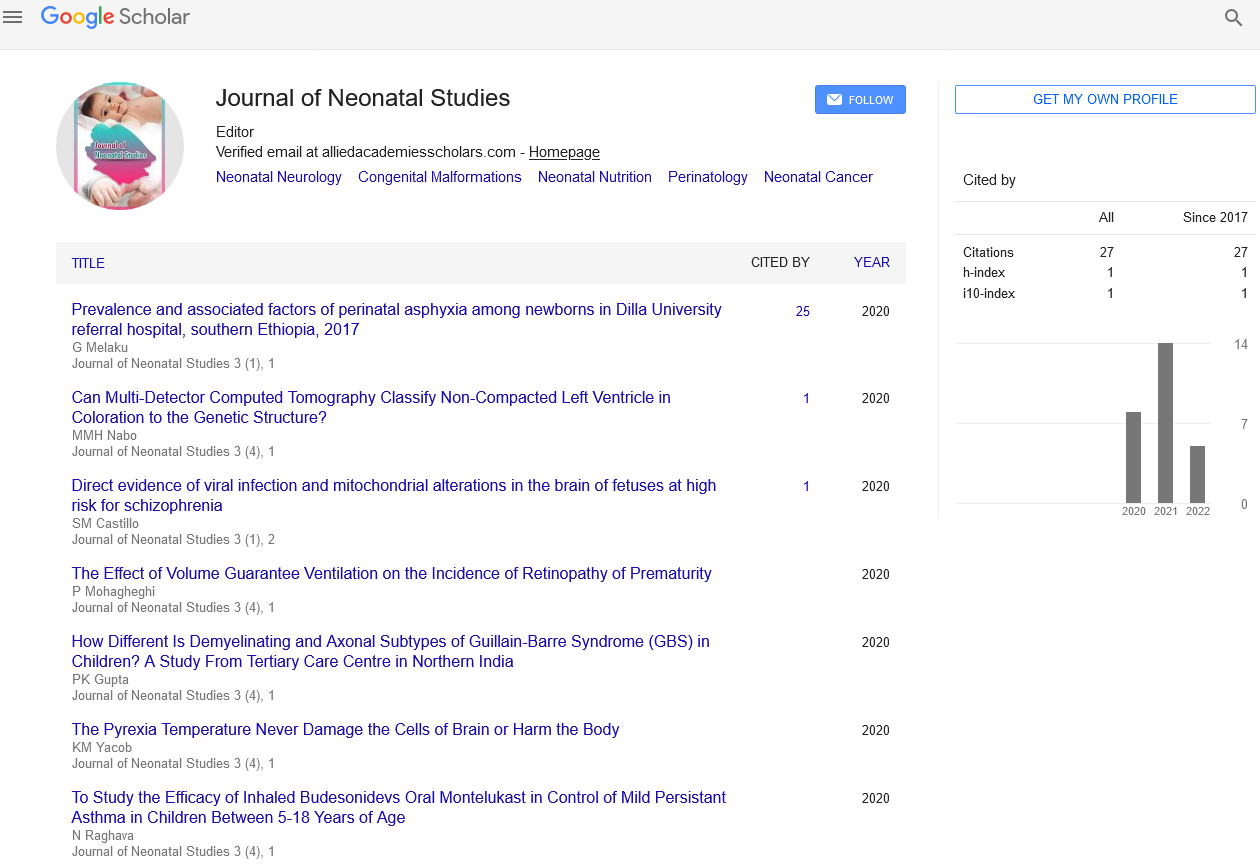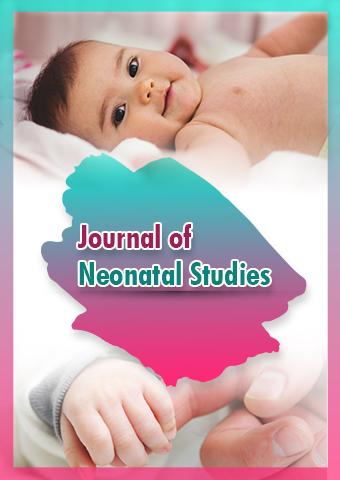Perspective - Journal of Neonatal Studies (2024) Volume 7, Issue 5
The Benefits of Infant Massage in Neonatal Care
- Corresponding Author:
- Astrid Maja
Department of Neonatal Physiotherapy Medicine, Red Cross University College, Sweden
E-mail: astrid.maja@rkh.se.in
Received: 02-Sep-2024, Manuscript No. JNS-24-150537; Editor assigned: 04-Sep-2024, PreQC No. JNS-24-150537 (PQ); Reviewed: 18-Sep-2024, QC No. JNS-24-150537; Revised: 23-Oct-2024, Manuscript No. JNS-24-150537 (R); Published: 30-Oct-2024, DOI: 10.37532/JNS.2024.7(5).288-290
Introduction
Infant massage involves the systematic and gentle manipulation of an infant’s body using various strokes and techniques. This practice is designed to create a sense of relaxation, improve physiological functions, and strengthen the bond between the caregiver and the baby. In neonatal care, infant massage is particularly valuable for preterm infants and those with medical conditions, as it can enhance their overall development and well-being.
Description
Benefits of infant massage
Infant massage offers a wide range of benefits that positively impact the physical, emotional, and developmental health of newborns. Some of the key benefits include:
Improved circulation: Gentle massage strokes help stimulate blood flow, promoting better circulation and oxygenation of tissues. This can aid in the overall growth and development of the infant.
Enhanced digestion: Massage can help alleviate gastrointestinal discomfort, such as gas and colic, by promoting better digestion and bowel movements. Techniques like “bicycle legs” and gentle belly rubs can provide relief for infants experiencing digestive issues.
Pain relief: Infant massage can reduce pain and discomfort associated with medical procedures, teething, and muscular tension. The release of endorphins during massage helps soothe and comfort the baby.
Boosted immunity: Regular massage can stimulate the lymphatic system, helping to strengthen the infant’s immune system and reduce the risk of infections.
Relaxation and sleep: Massage promotes relaxation by reducing stress hormones (cortisol) and increasing levels of relaxation hormones (oxytocin). This can lead to improved sleep patterns and overall better rest for the infant.
Neurological development: Sensory stimulation through touch is crucial for the development of the nervous system. Infant massage enhances neural connections, supporting cognitive and motor development.
Emotional bonding: The physical touch and eye contact during massage sessions foster a strong emotional bond between the caregiver and the baby. This bonding is essential for the infant’s emotional security and social development.
Weight gain and growth: Preterm infants who receive regular massage therapy often show improved weight gain and growth rates. The tactile stimulation and improved digestion contribute to better nutritional absorption and overall growth.
Techniques for infant massage
Infant massage involves various techniques that target different areas of the baby’s body. Some commonly used techniques include:
Stroking: Gentle, rhythmic strokes using the fingertips or palms help soothe and relax the baby. Stroking can be applied to the arms, legs, back, and chest.
Kneading: Light kneading motions using the fingers or thumbs can help relieve muscle tension and improve circulation. This technique is particularly effective for the back and limbs.
Swedish milking: This technique involves gentle squeezing and pulling motions along the limbs, mimicking the milking action. It helps promote blood flow and lymphatic drainage.
Tummy circles: Using the fingertips, caregivers can make small circular motions on the baby’s abdomen. This technique aids in digestion and alleviates gas and colic.
Foot reflexology: Massaging specific points on the baby’s feet can have a calming effect and promote relaxation. Each point corresponds to different organs and systems in the body.
Bicycle legs: Gently moving the baby’s legs in a cycling motion helps release trapped gas and improve bowel movements.
Guidelines for infant massage
To ensure the safety and effectiveness of infant massage, caregivers and healthcare providers should follow certain guidelines:
Timing: Choose a time when the baby is calm and alert, such as after a nap or feeding. Avoid massaging immediately after a meal to prevent discomfort.
Environment: Create a warm, quiet, and comfortable environment for the massage session. Use a soft blanket or mat to lay the baby on and ensure the room temperature is suitable.
Oil or lotion: Use a small amount of natural, hypoallergenic oil or lotion to reduce friction and make the massage smoother. Perform a patch test to check for any allergic reactions before using the oil on the baby’s skin.
Gentle pressure: Use gentle and light pressure when massaging the baby. Pay attention to the baby’s cues and adjust the pressure accordingly to ensure comfort.
Eye contact and communication: Maintain eye contact with the baby and talk or sing softly to create a soothing and engaging experience. This helps strengthen the emotional bond between the caregiver and the baby.
Duration: Start with short massage sessions of about 5-10 minutes and gradually increase the duration as the baby becomes more accustomed to the practice.
Avoid sensitive areas: Be cautious when massaging sensitive areas such as the fontanel (soft spot on the baby’s head) and avoid applying pressure on the spine.
Role of healthcare providers
Healthcare providers, including neonatologists, pediatricians, and neonatal nurses, play a crucial role in promoting and implementing infant massage in neonatal care. Their responsibilities include:
Education and training: Providing education and training to parents and caregivers on the benefits, techniques, and guidelines of infant massage. Demonstrating proper massage techniques and ensuring caregivers feel confident in performing the massage.
Assessment and recommendations: Assessing the infant’s medical condition and recommending massage therapy as part of the care plan. Identifying any contraindications or precautions based on the baby’s health status.
Integration into care plans: Integrating infant massage into the overall care plan for preterm and medically fragile infants. Collaborating with other healthcare professionals to ensure a holistic approach to neonatal care.
Research and advocacy: Conducting research on the benefits of infant massage and advocating for its inclusion in neonatal care practices. Promoting evidence-based practices and guidelines for infant massage therapy.
Parental involvement
Parents and caregivers play a central role in the practice of infant massage. Their involvement provides numerous benefits for both the baby and themselves:
Empowerment: Learning and practicing infant massage empowers parents to take an active role in their baby’s care. It fosters a sense of confidence and competence in caring for their newborn.
Emotional connection: The physical touch and interaction during massage sessions strengthen the emotional bond between parents and their baby. This connection is vital for the baby’s emotional development and well-being.
Stress reduction: Engaging in infant massage can reduce parental stress and anxiety, promoting a sense of calm and relaxation. It provides an opportunity for parents to connect with their baby on a deeper level.
Enhanced parenting skills: Parents who practice infant massage develop a better understanding of their baby’s cues and needs. This enhances their parenting skills and promotes a positive parenting experience.
Research and evidence-based practice
Numerous studies have demonstrated the benefits of infant massage in neonatal care. Research findings include:
Improved weight gain: Studies have shown that preterm infants who receive regular massage therapy exhibit better weight gain and growth rates compared to those who do not receive massage.
Enhanced neurodevelopment: Research indicates that infant massage can positively impact neurodevelopmental outcomes, including motor skills, cognitive function, and sensory processing.
Reduced hospital stay: Infants who receive massage therapy often have shorter hospital stays and faster recovery times, reducing healthcare costs and improving overall outcomes.
Pain relief and stress reduction: Studies have demonstrated that infant massage can reduce pain and stress levels in neonates, promoting a more comfortable and positive experience during medical procedures and hospital stays.
Conclusion
Infant massage is a valuable therapeutic intervention in neonatal care that offers numerous benefits for both infants and their caregivers. By promoting physical, emotional, and developmental health, infant massage supports the overall well-being of newborns. Healthcare providers play a crucial role in educating and guiding parents in the practice of infant massage, ensuring its safe and effective implementation. As research continues to validate the benefits of this ancient practice, infant massage is becoming an integral part of holistic neonatal care, enhancing the lives of infants and their families.

